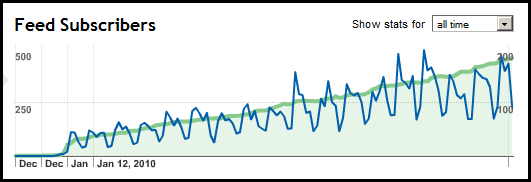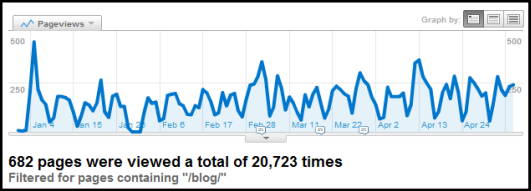I’m Susan Kistler, AEA’s Executive Director, and I contribute each Saturday’s post. Since we started aea365 on January 1, I’ve received questions about how we monitor readership.
Rad Resource: Feedburner is a free tool from Google through which you can ‘feed’ the content from your blog to track subscribers. It takes 2 minutes to set up and blog readers will be able to subscribe via email or RSS. Feedburner tracks subscribers (green line below) and how many people view or take action each day (blue line) either in the aggregate or by individual post. From Feedburner, we learned that we gain 3-4 new subscribers on average each day.
Rad Resource: Feedburner doesn’t tell you about website traffic – people interacting with the blog on the site itself. We use Google Analytics (GA) to learn about site traffic. GA takes a basic understanding of website management to install, but it is relatively quick to do for most sites. GA tells us how people engaged with the blog site as a whole or we can look at any single page. We can also tell things such as how readers found the site (using what search terms, from what referring sites, etc.), how readers move through the site, and how many pages they tend to view with each visit. Here is the blog pageviews report from GA (there are lots of other reports available). One thing we have learned is that site traffic stays relatively constant. It appears that people tend to visit the site and then sign up to receive the content via email or RSS (increases in subscribers seen in Feedburner tend to follow spikes in visits seen in GA). Curious why it shows 682 pages on the blog, but we’re only on day 130 or so? It is treating each page that you can call up based on tags as an independent page.
On both Feedburner and GA, we track changes after external events such as a newsletter article that refers people to the blog or mention of the blog during a webinar or on another blog.
Hot Tip: For many links, we use a URL shortener to track clickthroughs because clicks can be tracked in this way whether on the site, used by subscribers via email, or even if forwarded to a friend or colleague. I wrote more about clickthrough tracking in a previous post.
Finally, we monitor a number of other things about the blog including the nature and extent of comments and what prompts them, the number of backlinks to the blog from other sites, and the diversity of topics and contributors. I’ll write more about these in a future post, as well as how we’ll be reaching out to readers and members.





Pingback: Sheila B. Robinson on the Top 10 aea365 Posts of 2013! · AEA365
Excellent post on monitoring blog and web use!